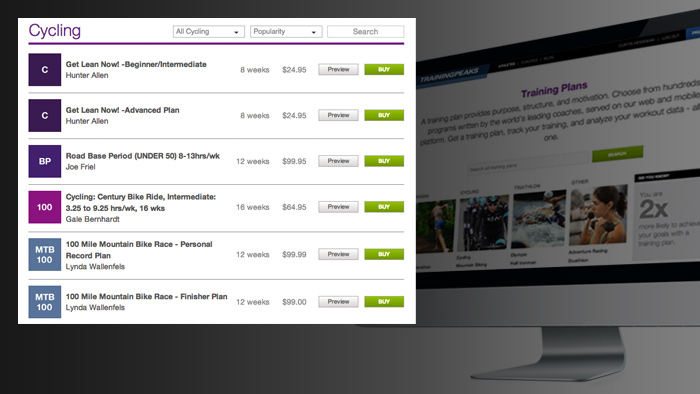Writing training plans is a great way to generate income, find and retain athletes and can help you save time. There are endless plan variations you can come up with, or you can simply use what you’ve already created and repurpose it for use in a plan. Now is a great time to think about growing your business using plans. Here are 5 reasons why you should be writing plans.
1. Generate Income
Obviously an important reason is to have another source of revenue for your company. Training plans are easy to create in the new TrainingPeaks. You can write a plan for a specific race, a specific distance, or a general season. You can co-brand your coaching with a local race director to help athletes navigate the training toward his race AND you can help beginners get started by helping them understand how to train. Plan sales can supplement your income during the busy months, and help generate more sales during the slower months. TrainingPeaks allows you to control the plan, from the structure to the naming and pricing.
2. Find Clients
Plans can also help you land more clients. Coaches can get reports to see who purchased their plans, so they can follow up with the athlete during the plan or afterwards. This is essentially generating leads for clients that have already used your services and are more likely to sign on for one on one coaching.
3. Retain Clients
Relevant to this time of year, offering an off season plan that keeps athletes connected to you will greatly increase your retention rate. How many athletes take a month or two off, with the plan of coming back, but end up never signing on again? In order to keep your athletes connected to you as a coach, you can and should offer a training plan to bridge the gap between the end of the season and the start of the new season. Sometimes, with a long-time athlete you can offer this for a nominal fee or even free. For an athlete who needs something specific you may want to charge a bit more, but still keep it reasonable price wise. You don’t need to do too much ‘coaching’ this time of the year, but have a plan that’s progressive and keeps the athlete working on their weaknesses, skills and drills.
4. Keep Athletes in Shape
The added benefit is that the athlete will be less likely to put on weight or lose too much fitness in the off season. Endurance athletes, typically being such Type A individuals, are usually going to hurt themselves if left to their own devices, either by under resting or by really under resting (read: doing nothing). Imagine if you coached an athlete to a great season, lots of Personal Bests and then when you picked back up with that athlete in January, they were 12 pounds overweight? Now, your coaching is really about working around an overweight athlete and getting them back to last season’s fitness levels, while dodging the landmines known as injuries. The first three months of training are just to get the weight off. Keeping an athlete on a plan helps them stay on track toward their long-term goals. If they are logging their workouts, you can even take a peek now and again to see what they are up to!
5. Work More Efficiently
Use workout schedules you have already created to make plans. For instance, let’s say you had an 8 week Half Ironman build that works really well for a busy executive, who trains on limited time. You can then copy that single 8 week block, with the new infinite scrolling feature you can copy as many weeks as you want at one time, and save it to a new ‘plan’. Then you can drop that plan into an athlete with the same type of work/training challenges. Once you realize what your niche is you’ll attract more and more of those same types of athletes and this just becomes easier and more time efficient as your plans evolve.
How to Write a Plan
Writing an actual plan is an easy process. Set up your plan creation in TrainingPeaks (see how here), then it’s as a simple as finding the workout in your library and dragging it on to the day you’d like for it to appear. If you create a generic plan, you can then customize for your specific athlete or group of athletes. Or, as mentioned in number 5 above, use existing workout schedules as internal plans for other athletes.
Staying organized is easy as well. Building up your library of plans can happen quickly and you have to name your plans so they are easy to find and access. I like to start with number of weeks, distance of plan, ability level, and then any special notes. So an Ironman plan that I’ve written for a hilly course, for a beginner, who has to do their long bike workouts on Sunday would be named something like this: “16 Week, Hilly Ironman, Beginner, Sunday long rides”. That is easy for me to catalog and pull up as I need it. Your list of plans can be endless as each athlete you create a plan for could have their own specific situation. The payoff comes when you copy and paste that plan into the calendar of an athlete that has the same basic tendencies.
Just as now is the dreaming season for athletes, now is the time for you to dream of where you want to take your business in 2015. For all of the reasons listed above, creating and using plans can help you grow and be a more efficient coach. Use your extra down time to brainstorm ideas around plans to sell and go through past athlete schedules and see which blocks of training you can pick out to copy and paste to a plan to use in the future. Organize your workouts, your training plans and to be ready to grow your business in 2015.
If you want to check out our current list of plans you can see them here.




